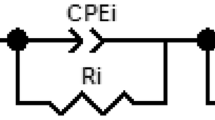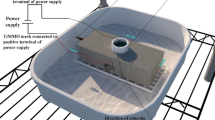Abstract
The research paper outlines an experimental setup to examine the blended and reinforced concrete strength and corrosion rate. Specimens were primed with reinforced steel, unary with 100% Ordinary Portland Cement (OPC), and quaternary consisting of the varying proportion of OPC (74%), Ground granulated blast-furnace slag (20%), Metakaolin (5%), and Colloidal nano-silica (1%). Therefore, cubes were fabricated and underwent a curing process lasting 7, 14, and 28 days. These specimens were then dispatched to evaluate their compressive strength, and a protocol established by an Indian standard was employed. In addition, a half-cell device was utilized to track the corrosion behaviour of the specimens. Outcomes of cured specimens proclaim the gain in compressive strength for the quaternary blended specimens and also show a reducing electrolyte potential of up to 3.82 × 10–7 A/m2 and a current electrolyte density of up to 2.42 × 10–7 A/m2 for the cathode to anode (C/A) ratio of 4/1 corrosion rate. The results indicate that a higher number of connected passive bars can lead to a faster anodic response rate and reduced potentiodynamic values. Comsol Multiphysics software was used to compute the concrete's potential and current density patterns using the finite-element technique.











Similar content being viewed by others
Data availability
Data cannot be shared openly but are available on request from authors.
References
Ahari, R. S., Erdem, T. K., & Ramyar, K. (2015). Permeability properties of self-consolidating concrete containing various supplementary cementitious materials. Construction and Building Materials, 79, 326–336. https://doi.org/10.1016/j.conbuildmat.2015.01.053
Ahmad, S. (2003). Reinforcement corrosion in concrete structures, its monitoring and service life prediction––a review. Cement and Concrete Composites, 25(4–5), 459–471. https://doi.org/10.1016/S0958-9465(02)00086-0
Almusallam, A. A., Al-Gahtani, A. S., & Aziz, A. R. (1996). Effect of reinforcement corrosion on bond strength. Construction and Building Materials, 10(2), 123–129. https://doi.org/10.1016/0950-0618(95)00077-1
Arya, C., & Vassie, P. R. W. (1995). Influence of cathode-to-anode area ratio and separation distance on galvanic corrosion currents of steel in concrete containing chlorides. Cement and Concrete Research, 25(5), 989–998. https://doi.org/10.1016/0008-8846(95)00094-S
Brooks, J. J., Johari, M. M., & Mazloom, M. (2000). Effect of admixtures on the setting times of high-strength concrete. Cement and Concrete Composites, 22(4), 293–301. https://doi.org/10.1016/S0958-9465(00)00025-1
Cai, Y., Zhang, W., Yu, L., Chen, M., Yang, C., Francois, R., & Yang, K. (2020). Characteristics of the steel-concrete interface and their effect on the corrosion of steel bars in concrete. Construction and Building Materials, 253, 1–13. https://doi.org/10.1016/j.conbuildmat.2020.119162.
Cao, Y., Gehlen, C., Angst, U., Wang, L., Wang, Z., & Yao, Y. (2019). Critical chloride content in reinforced concrete—An updated review considering Chinese experience. Cement and Concrete Research, 117, 58–68. https://doi.org/10.1016/j.cemconres.2018.11.020
Cavalier, P. G., Vassie, P. R., TRRL. (1981). Investigation and repair of reinforcement corrosion in a bridge deck. Proceedings of the Institution of Civil Engineers, 70(3), 461–480. https://doi.org/10.1680/iicep.1981.1784
Elahi, A., Basheer, P. A. M., Nanukuttan, S. V., & Khan, Q. U. Z. (2010). Mechanical and durability properties of high performance concretes containing supplementary cementitious materials. Construction and Building Materials, 24(3), 292–299. https://doi.org/10.1016/j.conbuildmat.2009.08.045
Elsener, B. (2000). corrosion of steel in concrete. Corrosion and Environmental Degradation, 2, 389–436. https://doi.org/10.1515/pm-2000-370205
Elsener, B., Andrade, C., Gulikers, J., Polder, R., & Raupach, M. (2003). Half-cell potential measurements, potential mapping on reinforced concrete structures. Materials and Structures, 36(7), 461–471. https://doi.org/10.1007/BF02481526
Ghods, P., Isgor, O. B., McRae, G. A., Li, J., & Gu, G. P. (2011). Microscopic investigation of mill scale and its proposed effect on the variability of chloride-induced depassivation of carbon steel rebar. Corrosion Science, 53(3), 946–954.
Gowers, K., & Millard, S. (1999). Measurement of concrete resistivity for assessment of corrosion. ACI Materials Journal, 96(5), 536–541. https://doi.org/10.14359/655
Heine, M. A., Keir, D. S., & Pryor, M. J. (1965). The specific effects of chloride and sulfate ions on oxide covered aluminum. Journal of the Electrochemical Society, 112(1), 24. https://doi.org/10.1149/1.2423459
Hogan, F. J., & Meusel, J. W. (1981). Evaluation for durability and strength development of a ground granulated blast furnace slag. Cement, Concrete and Aggregates,. https://doi.org/10.1016/j.conbuildmat.2019.116820
IS 10262. (2009). Guidelines for concrete mix design proportioning, New Delhi, India.
IS 12269. (1987). 53 grade ordinary Portland cement. New Delhi, India.
IS 1727. (1967). Methods of test for pozzolanic materials, New Delhi, India.
IS 383. (1970). Specification for coarse and fine aggregates from natural sources for concrete, New Delhi, India.
IS 456. (2000). Plain and Reinforced Concrete - Code of Practice, New Delhi, India.
IS 2386-2. (1963). Methods of test for aggregates for concrete, Part 2: Estimation of deleterious materials and organic impurities, New Delhi, India.
Johari, M. M., Brooks, J. J., Kabir, S., & Rivard, P. (2011). Influence of supplementary cementitious materials on engineering properties of high strength concrete. Construction and Building Materials, 25(5), 2639–2648. https://doi.org/10.1016/j.conbuildmat.2010.12.013
Kasaniya, M., & Thomas, M. D. (2022). Role of the alkalis of supplementary cementing materials in controlling pore solution chemistry and alkali-silica reaction. Cement and Concrete Research, 162, 107007. https://doi.org/10.1016/j.cemconres.2022.107007
Kenny, A., & Katz, A. (2020). Steel-concrete interface influence on chloride threshold for corrosion–Empirical reinforcement to theory. Construction and Building Materials, 244, 118376. https://doi.org/10.1016/j.conbuildmat.2020.118376
Kuder, K., Lehman, D., Berman, J., Hannesson, G., & Shogren, R. (2012). Mechanical properties of self consolidating concrete blended with high volumes of fly ash and slag. Construction and Building Materials, 34, 285–295. https://doi.org/10.1016/j.conbuildmat.2012.02.034
Li, C., Shu, G., Liu, W., & Duan, Y. (2020). The unified model for irradiation embrittlement prediction of reactor pressure vessel. Annals of Nuclear Energy, 139(107246), 1–6. https://doi.org/10.1016/j.anucene.2019.107246
Li, S., Lv, H., Huang, T., Zhang, Z., Yao, J., & Ni, X. (2022). Degradation of reinforced concrete beams subjected to sustained loading and multi-environmental factors. Buildings, 12(9), 1382. https://doi.org/10.3390/buildings12091382
Macdonald, D. D. (1992). The point defect model for the passive state. Journal of the Electrochemical Society, 139(12), 3434. https://doi.org/10.1149/1.2069096
Michel, A., Otieno, M., Stang, H., & Geiker, M. R. (2016). Propagation of steel corrosion in concrete: Experimental and numerical investigations. Cement and Concrete Composites, 70, 171–182. https://doi.org/10.1016/j.cemconcomp.2016.04.007
Raupach, M., & Gulikers, J. (1999). A simplified method to estimate corrosion rates- a new approach based on investigations of macrocells. In: Eighth International Conference on Durability of Building Materials and Components, 8 dbmc (pp. 376–385).
Revert, A. B., De Weerdt, K., Hornbostel, K., & Geiker, M. R. (2018). Carbonation-induced corrosion: Investigation of the corrosion onset. Construction and Building Materials, 162, 847–856. https://doi.org/10.1016/j.conbuildmat.2017.12.066
Saillio, M., Baroghel-Bouny, V., Pradelle, S., Bertin, M., Vincent, J., & de Lacaillerie, J. B. D. E. (2021). Effect of supplementary cementitious materials on carbonation of cement pastes. Cement and Concrete Research, 142, 106358. https://doi.org/10.1016/j.cemconres.2021.106358
Singh, J. K., & Singh, D. D. N. (2012). The nature of rusts and corrosion characteristics of low alloy and plain carbon steels in three kinds of concrete pore solution with salinity and different pH. Corrosion Science, 56, 129–142. https://doi.org/10.1016/j.corsci.2011.11.012
Singh, N., & Singh, S. P. (2016). Carbonation and electrical resistance of self compacting concrete made with recycled concrete aggregates and metakaolin. Construction and Building Materials, 121, 400–409. https://doi.org/10.1016/j.conbuildmat.2016.06.009
Sulapha, P., Wong, S. F., Wee, T. H., & Swaddiwudhipong, S. (2003). Carbonation of concrete containing mineral admixtures. Journal of Materials in Civil Engineering, 15(2), 134–143. https://doi.org/10.1061/(ASCE)0899-1561(2003)15:2(134)
Swamy, R. N., & Bouikni, A. (1990). Some engineering properties of slag concrete as influenced by mix proportioning and curing. Materials Journal, 87(3), 210–220.
Tabatabaeian, M., Khaloo, A., & Khaloo, H. (2019). An innovative high performance pervious concrete with polyester and epoxy resins. Construction and Building Materials, 228, 116820. https://doi.org/10.1016/j.conbuildmat.2019.116820
Tawfik, T. A., El-Yamani, M. A., Abd El-Aleem, S., Serag Gabr, A., & Abd El-Hafez, G. M. (2019). Effect of nano-silica and nano-waste material on durability and corrosion rate of steel reinforcement embedded in high-performance concrete. Asian Journal of Civil Engineering, 20, 135–147. https://doi.org/10.1007/s42107-018-0093-5
Vidal, T., Castel, A., & François, R. (2004). Analyzing crack width to predict corrosion in reinforced concrete. Cement and Concrete Research, 34(1), 165–174. https://doi.org/10.1016/S0008-8846(03)00246-1
Walsh, M. T., & Sagüés, A. A. (2016). Steel corrosion in submerged concrete structures—Part 1: Field observations and corrosion distribution modeling. Corrosion, 72(4), 518–533.
Warkus, J., & Raupach, M. (2006). Modelling of reinforcement corrosion–Corrosion with extensive cathodes. Materials and Corrosion, 57(12), 920–925. https://doi.org/10.1002/maco.200604032
Williamson, J., & Isgor, O. B. (2016). The effect of simulated concrete pore solution composition and chlorides on the electronic properties of passive films on carbon steel rebar. Corrosion Science, 106, 82–95. https://doi.org/10.1016/j.corsci.2016.01.027
Zornoza, E., Payá, J., & Garcés, P. (2009). Carbonation rate and reinforcing steel corrosion rate of OPC/FC3R/FA mortars under accelerated conditions. Advances in Cement Research, 21(1), 15–22. https://doi.org/10.1680/adcr.2007.00008
Funding
The authors declare that no funds, grants, or other support were received during the preparation of this manuscript.
Author information
Authors and Affiliations
Contributions
SK and MG both contributed equally to the research and writing of this manuscript. SK conceived the research idea, designed and performed the experiments, analyzed the data, and wrote the manuscript. MG supervised the research work, provided guidance throughout the research process, reviewed, edited and wrote few sections of the manuscript. Both authors have read and approved the final manuscript.
Corresponding author
Ethics declarations
Conflict of interest
The authors declare that they have no conflict of interest.
Additional information
Publisher's Note
Springer Nature remains neutral with regard to jurisdictional claims in published maps and institutional affiliations.
Rights and permissions
Springer Nature or its licensor (e.g. a society or other partner) holds exclusive rights to this article under a publishing agreement with the author(s) or other rightsholder(s); author self-archiving of the accepted manuscript version of this article is solely governed by the terms of such publishing agreement and applicable law.
About this article
Cite this article
Kudale, S.S., Gidde, M.R. Potentiodynamic resistance shifts in reinforcing steel placed in the concrete comprising supplementary cementitious material. Asian J Civ Eng 24, 2825–2835 (2023). https://doi.org/10.1007/s42107-023-00677-3
Received:
Accepted:
Published:
Issue Date:
DOI: https://doi.org/10.1007/s42107-023-00677-3




